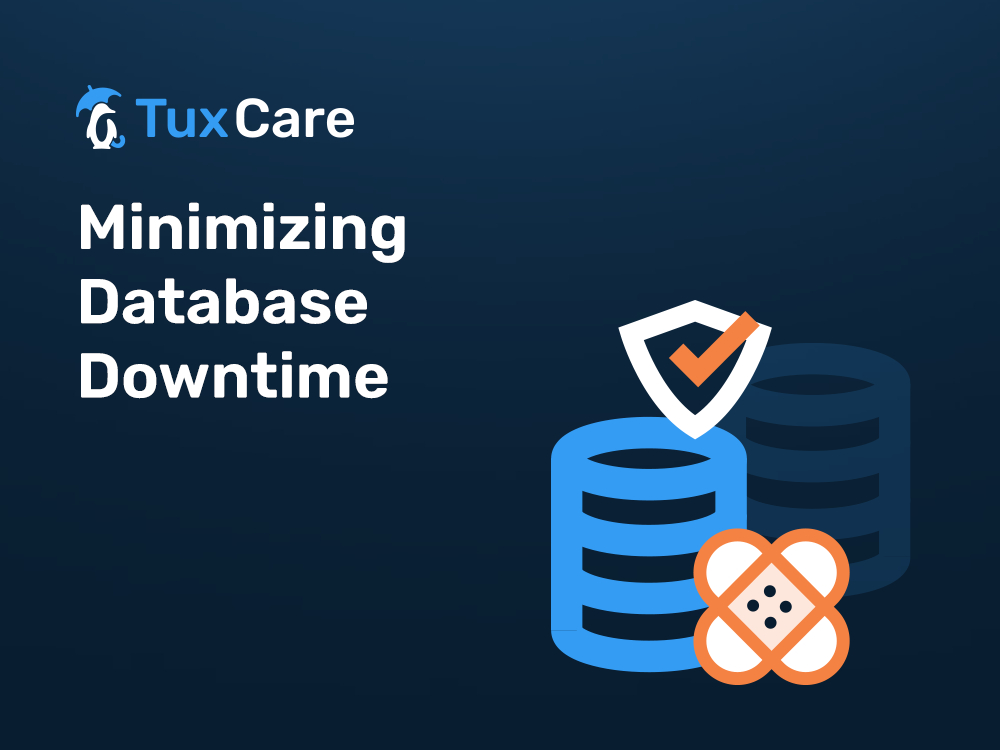Minimizing Database Downtime
Keeping databases patched with the latest security updates is essential for organizations to protect their data. Unpatched database systems can lead to exploits against core system operations, including front-end applications. Hackers will often exploit hosts, including databases, to serve as the launch platforms for their attacks.
This is why organizations prioritize vulnerability patching to protect themselves. Keeping these database vulnerabilities patched, however, can involve scheduling downtime to apply the security updates – which can lead to business disruptions that nobody wants to deal with.
Fortunately, keeping databases patched is possible without taking systems out of production or needing to schedule a maintenance window. It’s called live patching – but, before we get into that, let’s dive a little deeper into database downtime.
Why Is Database Uptime so Critical?
Corporate applications, client-facing platforms, and data analytics rely heavily on database performance, uptime, and security. If client data becomes exposed to security vulnerabilities or the database crashes during a replication job, this will cause data integrity implications.
Moreover, database integrity issues could lead to failure to comply with compliance and privacy laws – not to mention the loss of consumer trust. Add that to the financial consequences of cleaning up the mess that follows a database security incident, and any company could reach the point of no return. The cost of a single data breach in the United States in 2022, for example, was $9.44 million (IBM).
Organizations’ revenues rely on their high-performance, mission-critical application and database services. So, any impact on their users, partnerships, and supply chain ecosystem because of database outages or security breaches will cause the company to lose more than just revenue.
What Leads to Database Downtime?
Several predictable and unpredictable circumstances, including common vulnerabilities becoming exploited by cybercriminals within the networks, databases, and front-end applications, could cause downtime of any system.
Organizations often schedule a change control window to perform critical maintenance on their databases, corresponding front-end systems, and associated networks. Most times, unplanned data downtime could occur because the upgrade failed, the SecOps and database administrators did not have a rollback plan in their scheduled maintenance plan, or even a natural disaster happened – including power failures or facility damage.
Maintenance-Related Downtime
Upgrading any IT system is a complex process. Even with the most comprehensive change control and maintenance windows procedures, planned maintenance could turn into an unexpected outage. During a scheduled outage, if the various SecOps, DevOps, and sysadmins cannot capture all dependencies, this could lead to an unexpected production disruption.
During which operations can this happen?
- Database and Network Upgrades: Database patching matters to organizations. It complicated upgrading databases and network maintenance routines open to unforeseen outages and technical complications.
- Routine Maintenance: Databases system maintenance incorporates several steps in patching and upgrading:
- Applying security patches for open-source databases
- Updating data tables and stored procedures
- Performing data replication to a backup system before applying the patches
Database systems are also at the bottom of most application stacks inside an organization, so any system, front-end or back-end, is inevitably working with, adding to, or modifying the data contained in a database, somewhere. When this dependency is indirect, it is even possible for a database outage to cause disruption in systems that at first glance could seem disconnected from it – through an API or a third-party gateway application.
The complexity of database patching can lead to unexpected downtime. Vendor patches sometimes cause unforeseen corruption in the database tables or stored procedures, leading to unplanned outages. SecOps and SQL database engineers often test vendor patches and update within their dev/QA/staging platforms to validate that the upgrade software works as expected. Often, issues not found in QA will surface on production systems, causing unexpected downtime.
To help prevent this, SysAdmins and SQL DBAs should request a change control window, even the most minor maintenance routine, to avoid any unplanned production outage.
Similar to the database upgrades mentioned above, the decision to migrate to another platform also could lead to unexpected outages. Simply migrating to the cloud poses several risks to database operations, including incomplete data replication because of unpredictable network latency. Failure to complete a migration data replication could have severe implications for an organization attempting to move back to a positive steady state for application and database operations.
What about Other Types of Unplanned Downtime?
In many cases, database downtime can occur as a result of events that are even further out of IT/SecOps teams’ control:
- Power outages/natural disasters: Aside from unexpected issues about the database and other IT systems during a change control window, natural disasters, including earthquakes, flooding, and fires, can cause power outages and access to critical facilities. The impact and duration of these natural disasters are challenging to predict.
- Server or storage failure: Database systems rely on the network for connectivity, servers hosting the database application, and the storage tier to house the actual data files. Any failure within these layers can cause a production outage. Storage clusters and servers support an HA design and fail-over. However, organizations often only test these capabilities after the initial setup if mandated by a customer or security mandate.
- Human error: All critical systems, including databases, networks, applications, and operations, are maintained by human engineers. Human error is a leading factor that leads to an organization being exposed to cybercriminal attacks. Errors in patching and configuration will lead to vulnerabilities becoming exploited, potentially resulting in data loss and systems unavailability.
Measuring Uptime for Databases and Systems
Organizations within the technology industry often measure themselves based on the “five nines” scales based on available and acceptable levels of downtime. An organization will promote its five nines availability as a competitive advantage in its respective market.
Moreover, organizations will strive to deliver five nines availability through comprehensive patching management, security operations, and overall IT management processes.
AWS published a chart breakdown on their website that displays the acceptable levels of outage time:
As an additional factor, it’s not only that 0.001% of downtime happens – it is also relevant knowing when such an outage happens. It is very different for an outage to happen outside of regular business hours or during the peak of sales activity during a holiday season. And, if there is one thing IT practitioners have learned over the years, it’s that – according to Murphy’s Law – the outage always happens when it’s least expected and desired.
Modernizing Patch Management to Minimize Outages
Organizations wanting to reduce the complexity of database security patching and risk of human error have digitally transformed their vulnerability patching approach by adopting live patching through TuxCare. TuxCare’s live patching solution for databases, called DBCare, enables teams to deploy patches to database systems without needing to reboot or schedule downtime – completely eliminating patching-related outages.
Plus, DBCare supports MySQL, MariaDB, and PostgreSQL – regardless if they live in an on-premises data center or within AWS Aurora or Relational Database Services (RDS) offerings.
Another critical component of TuxCare’s live patching is the support for complete automation and support for a closed-loop air-gap deployment option. Our live patching technology delivers the most up-to-date security updates while only requiring minimal human interaction, resulting in fewer errors and reduced vulnerability exposure.
TuxCare also offers live patching for shared libraries, virtual machine environments, IoT devices, and all popular enterprise Linux distributions – unlike many live patching alternatives that are only functional for a single distribution or a few.
Schedule a conversation with one of our experts to get a personalized explanation of how TuxCare’s live patching automation works.



 Documentation
Documentation Login
Login



